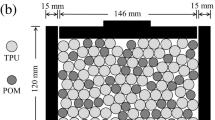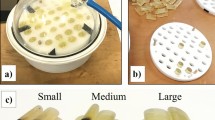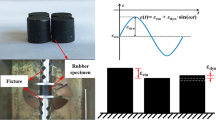Abstract
Infrared thermography was used to study the thermal signature of a rubber-like granular material subjected to cyclic confined compression. The discrete medium consisted of cylinders placed in parallel. A fluctuation of the temperature at the same frequency as the mechanical loading was observed, as well as a global self-heating as the cycles progressed. This can be associated with the thermoelastic coupling effect and the mechanical dissipation effect, respectively. The thermoelastic coupling effect is visible in all contact zones between the particles, which can be explained by the stress concentrations that occur there. A strong mechanical dissipation effect occurs at specific contacts, which can be explained by the high friction between certain particles.
Access provided by Autonomous University of Puebla. Download conference paper PDF
Similar content being viewed by others
Keywords
- Granular material
- Rubber-like material
- Infrared thermography
- Thermoelastic coupling
- Intrinsic dissipation
14.1 Introduction
Granular materials are omnipresent around us, in many industrial fields and in many natural phenomena. Rice and sugar are used in the food industry and in our daily lives. Sand and rocks are commonly used in civil engineering for the construction of buildings or streets. Granular flows are involved in avalanches and landslides. In the context of engineering, granular materials can be defined as a set of solid particles whose macroscopic mechanical behavior is governed by interparticle forces, i.e., contact forces between particles. Granular media are generally made up of grains having various distributions in terms of size, shape, and base material. This leads to a variety of mechanical phenomena that are not yet clearly understood. Numerical simulations have been widely used to study the influence of parameters such as particle shape, density, polydispersity, elasticity, and friction [1]. Several experimental techniques are also available. For measurements in the volume, we can mention X-ray tomography [2]. For surface measurements, particle image velocimetry and digital image correlation are widely used [3,4,5,6,7,8,9]. Stress fields can be obtained by photoelasticimetry measurement using particles made of birefringent materials [10,11,12]. Mechanoluminescent materials have also been used to visualize the intensity of interparticle contacts [13]. In most of the studies available in the literature, the particles are rigid or hard. Contact stiffness is then the main parameter. A granular system consisting of soft matter is more complex to analyze. Recently, the compaction of highly deformable particle assemblies has been performed numerically in Ref. [14], opening the possibility of comparison with experimental results for soft granular materials.
Infrared (IR) thermography has also been used to measure the thermal signature of the mechanical response of soils and sands [15,16,17]. Some studies have mainly focused on Schneebeli materials (two-dimensional discrete media made with cylinders) in order to analyze the contact zones between the particles, i.e., the stress concentration zones [18,19,20,21,22]. In the present study, IR thermography was used to analyze the thermal response of Schneebeli media made of thermoplastic polyurethane (TPU). Temperature changes were measured with an IR camera during cyclic confined compression. The objective was to distinguish the thermoelastic coupling effect (associated with reversible mechanical behavior) and the mechanical dissipation effect (associated with irreversible mechanical behavior).
14.2 Experimental Preparation
The experimental setup is presented in Fig. 14.1. A granular sample was prepared by randomly placing cylinders with elliptical cross-section into a rectangular metallic frame: see the schematic view in Fig. 14.1a. The particles were made of TPU manufactured by using an in-house device. Each particle was molded at ambient temperature in a vacuum chamber to avoid bubble formation. One side of the elliptical face of each cylinder was polished to obtain a smooth surface perpendicular to the longitudinal axis. To maximize the thermal emissivity of the surfaces observed by the camera (and thus reduce reflections in the IR range), a matt black paint was sprayed on the particle cross-sections as well as on the frame containing the granular system. Black curtains and cardboards were also placed around the device (not visible in Fig. 14.1b) to minimize parasitic reflections.
A cyclic triangular compressive loading was applied on the top of the granular system by using a Zwick/Roell ZMART PRO testing machine through a pusher (see Fig. 14.1b). The minimum and maximum forces were set to −1200 N and − 12,000 N, respectively. The loading was force-controlled with a force rate equal to 900 N/s, leading to cycle duration of 24 s. Note that some preliminary mechanical cycles were applied in order to compact the granular system. Next, the minimum force was kept constant for about 10 min to ensure that a steady thermal equilibrium of the system was reached before starting the cyclic loading.
A Cedip Jade III-MWIR camera was utilized to capture the temperature fields on the surface of each elliptical particle during the mechanical loading at a recording frequency of 10 Hz. In practice, the base acquisition frequency of the camera was set to 100 Hz with a real-time averaging every ten images in order to improve the thermal measurement resolution. The resulting standard deviation of the thermal noise (measurement resolution) was lower than 0.01 °C thanks to this real-time average operation.
Temperature maps were also captured during 5 seconds just before the beginning of the cyclic loading in order to define the reference temperature field. Figure 14.2a shows the field of temperature differences at the beginning of the mechanical test with respect to this reference thermal state in order to reveal the spatial noise during the test. The corresponding distribution of the values within the particles (i.e., excluding the voids between the particles) is displayed in Fig. 14.2b. Values lower than about −0.04 °C are due to pixels near the boundary of the particles. The standard deviation of the distribution within the [−0.04 °C; 0.04 °C] range is equal to 0.012 °C.
14.3 Thermomechanical Background
Thermomechanical couplings in materials can be separated into two different parts, namely a part associated to reversible processes (elasticity) and a part associated to irreversible processes (e.g., plasticity, viscosity, fatigue damage, friction):
-
The first case is called thermoelastic coupling. Two types of coupling between temperature and strain must be considered according to the physics associated with elasticity: isentropic coupling governed by thermal expansion or compression; and entropic coupling governed by the degree of disorder. In rubber-like materials, entropic coupling becomes dominant over isentropic coupling as soon as the level of deformation is greater than 10% [23].
-
In the second case, the associated calorific quantity d1 (in W/m3) is called mechanical dissipation or intrinsic dissipation. It is worth remembering that it is different from the thermal dissipation d2, the two types of dissipation being involved in the Clausius-Duhem inequality d1 + d2 > 0.
Mechanical dissipation can be revealed through the temperature change over integer numbers of mechanical cycles. Indeed, heat quantities due to reversible mechanical phenomena are null over a thermodynamical cycle. More precisely, the heat quantities upon loading and unloading are equal in magnitude but opposite in sign. On the contrary, the mechanical dissipation is positive whatever the loading evolution: d1 > 0. Thermoelastic coupling is a “strong” coupling. Indeed, the corresponding heat power density is much higher in magnitude than the mechanical dissipation in most cases. Extracting mechanical dissipation effect from the global thermal response of the material is in general possible for a cyclic loading, for which thermoelastic coupling effect vanishes cyclically. Moreover, the heat produced by irreversible phenomena accumulates over the cycles (because d1 is always positive), which helps to experimentally identify this quantity. In the present experiment, thermoelastic coupling was evidenced by considering half of the first mechanical cycle (assuming that the mechanical dissipation is low over this duration) whereas mechanical dissipation was highlighted by considering ten cycles.
14.4 Analysis of the Reversible Mechanical Phenomena
Figure 14.3 shows the temperature change field at the half of the first mechanical cycle. “Hot” zones are clearly evidenced at each contact between the particles. They are also visible at the contacts with the metallic frame. They are logically due to the stress concentrations resulting mainly a priori from the normal interparticle forces. The largest temperature increase is observed in the upper left corner of the granular material. Tangential forces may be also involved in this zone, as revealed by the analysis of the thermal signature of the irreversible mechanical phenomena in the next section.
14.5 Analysis of the Irreversible Mechanical Phenomena
Figure 14.4 presents the field of temperature change at the end of the tenth mechanical cycle. Based on the assumption that the heat quantity due to the thermoelastic coupling is null over the preceding successive mechanical cycles, this map displays a thermal signature of the mechanical dissipation effect, i.e., of the irreversible mechanical phenomena. In granular media, this latter quantity can be mainly associated to friction at the contacts. However, viscosity and damage in the volume can be also involved, especially in the zones subjected to high stress levels. Figure 14.4 clearly shows that the mechanical dissipation effect is not present at all the contacts, which strongly differs from the case of the thermoelastic coupling effect (compare with Fig. 14.3). “Hot” zones are now mainly visible only in the upper two corners of the granular system. This can be explained by the greater movement of the particles in the upper two corners, potentially leading to greater friction. It can also be observed that the size of the “hot” zones is quite large, which can be explained by the heat diffusion over the ten cycles.
Finally, Fig. 14.5 shows the variation in time of the temperature at a given interparticle contact located in the upper left part of the granular material: see point A in the schematic view. As expected, the temperature oscillates at the same frequency as the mechanical loading. It can be seen that the mean temperature change first increases over the cycles and then stabilizes from nearly the seventh cycle: see the red dashed curve. This increase can be attributed to the monotonous production of mechanical dissipation over the cycles. The stabilization results from the equilibrium between the heat produced by the mechanical irreversible phenomena at point A and the heat diffused to the environment of point A.
14.6 Conclusion
IR thermography is in principle applicable to analyze thermomechanical phenomena of any types of material. However, it remains difficult to apply to cohesionless granular materials, which explains the small numbers of studies published in the literature (see Refs [15,16,17,18,19,20,21,22,22]). The objective of this study was to analyze the thermomechanical response of a two-dimensional granular system made from TPU cylinders with elliptical cross-section. A cyclic compression loading was applied to a granular system while an IR camera measured the resulting temperature changes. The thermoelastic coupling effect and the mechanical dissipation effect were distinguished in the thermal response. The thermoelastic coupling effect is clearly visible in the contact zones between the particles, which can be explained by the stress concentrations occurring there. The mechanical dissipation effect manifests itself in specific contacts, which can be explained by the high friction between certain particles.
References
Radjai, F., Roux, J.N., Daouadji, A.: Modeling granular materials: century-long research across scales. J. Eng. Mech. 143, 04017002 (2017)
Khalili, M.H., Brisard, S., Bornert, M., Aimedieu, P., Pereira, J.M., Roux, J.N.: Discrete digital projections correlation: a reconstruction-free method to quantify local kinematics in granular media by X-ray tomography. Exp. Mech. 57, 819–830 (2017)
Slominski, C., Niedostatkiewicz, M., Tejchman, J.: Application of particle image velocimetry (PIV) for deformation measurement during granular silo flow. Powder Technol. 173, 1–18 (2007)
Hall, S.A., Wood, D.M., Ibraim, E., Viggiani, G.: Localised deformation patterning in 2D granular materials revealed by digital image correlation. Granul. Matter. 12, 1–14 (2010)
Richefeu, V., Combe, G., Viggiani, G.: An experimental assessment of displacement fluctuations in a 2D granular material subjected to shear. Geotech Lett. 2, 113–118 (2012)
Karanjgaokar, N., Ravichandran, G.: Experimental inference of inter-particle forces in granular systems using digital image correlation. In: Jin, H., Sciammarella, C., Yoshida, S., et al. (eds.) Advancement of Optical Methods in Experimental Mechanics, pp. 379–385. Springer, Berlin (2014)
Karanjgaokar, N., Ravichandran, G.: Study of energy contributions in granular materials during impact. In: Song, B., Lamberson, L., Casem, D., et al. (eds.) Dynamic Behavior of Materials, p. 199. Springer, New York (2015)
Hurley, R., Marteau, E., Ravichandran, G., Andrade, J.E.: Extracting inter-particle forces in opaque granular materials: beyond photoelasticity. J. Mech. Phys. Solids. 63, 154–166 (2014)
Hurley, R.C., Lim, K.W., Ravichandran, G., Andrade, J.E.: Dynamic inter-particle force inference in granular materials: method and application. Exp. Mech. 56, 217–229 (2016)
Shukla, A., Damania, C.: Experimental investigation of wave velocity and dynamic contact stresses in an assembly of disks. Exp. Mech. 27, 268–281 (1987)
Roessig, K.M., Foster, J.C., Bardenhagen, S.G.: Dynamic stress chain formation in a two-dimensional particle bed. Exp. Mech. 42, 329–337 (2002)
Mirbagheri, S.A., Ceniceros, E., Jabbarzadeh, M., McCormick, Z., Fu, H.C.: Sensitively photoelastic biocompatible gelatin spheres for investigation of locomotion in granular media. Exp. Mech. 55, 427–438 (2015)
Jongchansitto, P., Boyer, D., Preechawuttipong, I., Balandraud, X.: Using mechanoluminescent materials to visualize interparticle contact intensity in granular media. Exp. Mech. 60, 51–64 (2020)
Cantor, D., Cardenas-Barrantes, M., Preechawuttipong, I., Renouf, M., Azema, E.: Compaction model for highly deformable particle assemblies. Phys. Rev. Lett. 124, 208003 (2020)
Luong, M.P.: Characteristic threshold and infrared vibrothermography of sand. Geotech. Test. J. 9, 80–86 (1986)
Luong, M.P.: Infrared Thermography of the Dissipative Behaviour of Sand, pp. 199–202. A.A. Balkema Publishers, Leiden, Netherlands (2001)
Luong, M.P.: Introducing infrared thermography in soil dynamics. Infrared Phys Technol. 49, 306–311 (2007)
Jongchansitto, P., Balandraud, X., Grédiac, M., Beitone, C., Preechawuttipong, I.: Using infrared thermography to study hydrostatic stress networks in granular materials. Soft Matter. 10, 8603–8607 (2014)
Chaiamarit, C., Balandraud, X., Preechawuttipong, I., Grédiac, M.: Stress network analysis of 2D non-cohesive polydisperse granular materials using infrared thermography. Exp. Mech. 39, 761–769 (2015)
Jongchansitto, P., Balandraud, X., Preechawuttipong, I., Le Cam, J.-B., Garnier, P.: Thermoelastic couplings and interparticle friction evidenced by infrared thermography in granular materials. Exp. Mech. 58, 1469–1478 (2018)
Jongchansitto, P., Preechawuttipong, I., Balandraud, X., Grédiac, M.: Numerical investigation of the influence of particle size and particle number ratios on texture and force transmission in binary granular composites. Powder Technol. 308, 324–333 (2017)
Jongchansitto, P., Yachai, T., Preechawuttipong, I., Boufayed, R., Balandraud, X.: Concept of mechanocaloric granular material made from shape memory alloy. Energy. 219, 119656 (2021)
Balandraud, X., Le Cam, J.B.: Some specific features and consequences of the thermal response of rubber under cyclic mechanical loading. Arch. Appl. Mech. 84, 773–788 (2014)
Acknowledgments
K. Jongchansitto would like to acknowledge the National Research Council of Thailand (NRCT) through the Royal Golden Jubilee Ph.D. program (grant no. PHD/0100/2561) for the support during this research.
Author information
Authors and Affiliations
Corresponding author
Editor information
Editors and Affiliations
Rights and permissions
Copyright information
© 2022 The Society for Experimental Mechanics, Inc.
About this paper
Cite this paper
Jongchansitto, K. et al. (2022). Analysis of the Thermomechanical Response of a Rubber-like Granular Material. In: Kramer, S.L., Tighe, R., Lin, MT., Furlong, C., Hwang, CH. (eds) Thermomechanics & Infrared Imaging, Inverse Problem Methodologies, Mechanics of Additive & Advanced Manufactured Materials, and Advancements in Optical Methods & Digital Image Correlation, Volume 4. Conference Proceedings of the Society for Experimental Mechanics Series. Springer, Cham. https://doi.org/10.1007/978-3-030-86745-4_14
Download citation
DOI: https://doi.org/10.1007/978-3-030-86745-4_14
Published:
Publisher Name: Springer, Cham
Print ISBN: 978-3-030-86744-7
Online ISBN: 978-3-030-86745-4
eBook Packages: EngineeringEngineering (R0)









